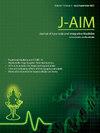Efficacy of topical analgesia Zanthoxylum rhetsa in the treatment of primary knee osteoarthritis: A randomized, double-blind, positive-controlled clinical trial
IF 1.9
Q3 INTEGRATIVE & COMPLEMENTARY MEDICINE
引用次数: 0
Abstract
Background
The essential oil from the pericarp (EOP) of Zanthoxylum rhetsa (Roxb.) DC. inhibits prostaglandin E2, which is related to knee osteoarthritis (OA). However, there is no clinical report on its efficacy.
Objectives
To assess the efficacy of EOP in Z. rhetsa (ZR) spray as a novel spray compared to diclofenac (DF) spray in elderly individuals diagnosed with primary knee OA.
Methods
60 patients with unilateral knee pain over three months were randomly assigned to either the ZR spray (experimental) or DF spray (control) group. Each group applied the spray topically 3 times daily (2 mL each time) for 14 consecutive days. Follow-ups occurred after day 7 and after day 14. Primary outcomes included pain score measurements, with secondary outcomes focusing on WOMAC index scores.
Results
The ZR and DF spray groups did not significantly differ at baseline. ZR spray is the first to demonstrate non-inferior efficacy compared to DF spray, with no significant difference in the mean change of pain scores at rest after 10 min (effect size <0.2) and following a 20-m walk test (effect size <0.5), including walking time (effect size <0.2), as well as in WOMAC index scores (effect size <0.3) from baseline to the first and second visits. Additionally, patients treated with ZR spray required less oral medication from the first visit.
Conclusions
Analgesia and improved knee functionality provided by ZR spray are suitable for combined treatment in elderly patients with co-morbidities or limited oral NSAID medication due to increased risk.
局部镇痛花椒治疗原发性膝骨关节炎的疗效:一项随机、双盲、阳性对照临床试验
花椒(Zanthoxylum rhetsa, Roxb.)果皮精油直流。抑制前列腺素E2,前列腺素E2与膝骨关节炎(OA)有关。但目前尚无临床疗效的报道。目的对比双氯芬酸(DF)喷雾剂与Z. rhetsa (ZR)喷雾剂EOP在老年原发性膝关节OA患者中的疗效。方法将60例3个月以上单侧膝关节疼痛患者随机分为ZR喷雾组(实验组)和DF喷雾组(对照组)。每组每日局部喷雾剂3次(每次2ml),连续14天。随访时间分别为第7天和第14天。主要结局包括疼痛评分测量,次要结局关注WOMAC指数评分。结果ZR和DF喷雾组在基线时无显著性差异。与DF喷雾相比,ZR喷雾首次显示出不逊色的疗效,10分钟后休息疼痛评分(效应值<;0.2)和20米步行测试(效应值<;0.5),包括步行时间(效应值<;0.2)以及从基线到第一次和第二次就诊的WOMAC指数评分(效应值<;0.3)的平均变化无显著差异。此外,接受ZR喷雾剂治疗的患者从第一次就诊开始就需要较少的口服药物。结论ZR喷雾剂镇痛及改善膝关节功能,适用于合并合并症或口服非甾体抗炎药(NSAID)风险增加而限制用药的老年患者的联合治疗。
本文章由计算机程序翻译,如有差异,请以英文原文为准。
求助全文
约1分钟内获得全文
求助全文
来源期刊

Journal of Ayurveda and Integrative Medicine
INTEGRATIVE & COMPLEMENTARY MEDICINE-
CiteScore
4.70
自引率
12.50%
发文量
136
审稿时长
30 weeks
 求助内容:
求助内容: 应助结果提醒方式:
应助结果提醒方式:


